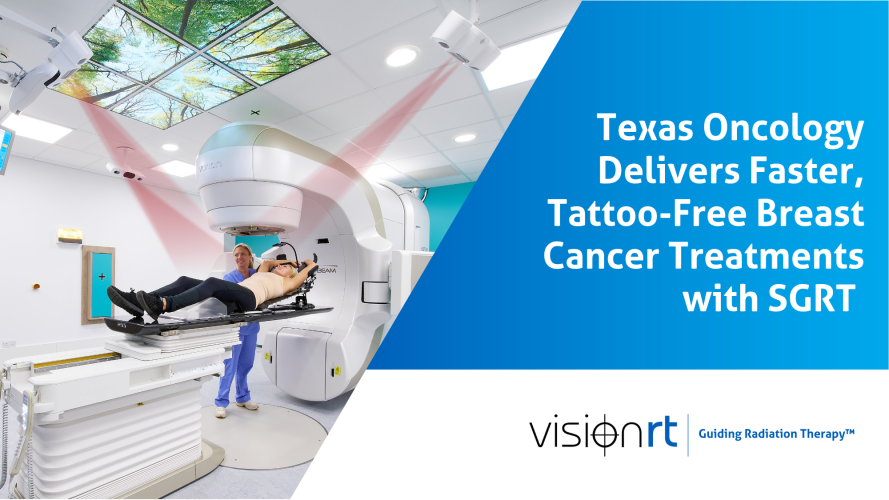Texas Oncology Delivers Faster, Tattoo-Free Breast Cancer Treatments with SGRT

At Texas Oncology, the adoption of Surface Guided Radiation Therapy (SGRT) has reshaped both breast and Deep Inspiration Breath Hold (DIBH) treatments. As part of Breast Cancer Awareness Month, Vision RT spoke with Jessica Ikner, Chief Radiation Therapist, about how SGRT has changed workflows, improved accuracy, and enhanced the patient experience.
Breast Treatment Before SGRT
Texas Oncology treats approximately 15–20 patients per day at this site, with breast cancer patients representing the majority. Prior to adopting SGRT, breast setups often required multiple verification images and iterative adjustments to patient positioning. “Before SGRT, it meant taking an image, going into the room, moving the arm or shoulder two millimetres, then imaging again, and sometimes realizing we’d gone too far. It could turn into this cycle of adjustments,” explained Jessica.
Boosting Efficiency and Accuracy with SGRT
For Texas Oncology, implementing SGRT delivered immediate benefits in two key areas: setup accuracy and treatment efficiency.
“With SGRT, our setups are consistently accurate,” says Jessica. “This significantly reduced the need for repeated imaging and repositioning. Treatments that previously required 20 minutes can now be completed in 10–15 minutes, which not only streamlines workflow but also improves patient experience.”
The efficiency gains are particularly impactful for DIBH cases, where reproducibility and precise breath-hold positioning are critical. SGRT enables therapists to guide patients into the correct position and monitor them in real-time, supporting both heart-sparing and patient comfort.
Jessica also highlighted the value of AlignRT’s Postural Video feature: “It clearly shows where the chin, hands, and hips should be,” she noted. “For complex setups, it removes uncertainty and gives therapists confidence in each fraction.” With its intuitive design, Postural Video gives therapists a multi-angle, real-time view of the patient’s overall alignment relative to their reference position during setup and monitoring by using an outline of the reference surface and a live video stream of the patient.
A Patient-First Approach: Eliminating Tattoos and Marks
One of the most significant cultural shifts for the department was transitioning away from permanent tattoos and large skin marks. Historically, tattoos were viewed as essential for treatment verification. With SGRT, however, the team gained confidence in relying on surface guidance for accurate setup.
“Due to the accuracy of SGRT, our Radiation Oncologists are happy that the patients no longer require any skin markings or tattoos, which is a big deal for female patients,” Jessica noted. “In the past, patients would have large markings to confirm fields. With SGRT, we’ve eliminated that, something patients are really grateful for.”
The transition was gradual. Initially, the team retained small reference marks or crosshairs as a safety net while validating SGRT’s accuracy. These were phased out as therapists gained confidence in the system’s reproducibility and precision. As evidence has grown, many departments now feel confident going tattoo- and mark-free from the outset.
“It’s a mindset shift,” Jessica admitted. “As therapists, we were trained to verify fields on the skin. To suddenly let go of tattoos felt like a big deal. But once we saw that SGRT was consistently giving us accurate setups, we became confident in relying fully on it.”
For Jessica and her team, SGRT is now indispensable: “Once we saw how consistently accurate it was, we became confident in relying fully on it. Now, we couldn’t imagine going back.”
Get in touch
Ready to take the next step?
Vision RT’s family of SGRT solutions guide radiation therapy for better patient care at every step: Sim, Planning, Treatment and Dose. Whether you’re looking for a quote, a product demo (virtual or in-person) or just more information, please get in touch.